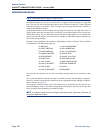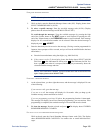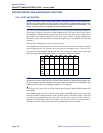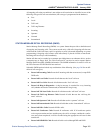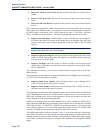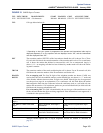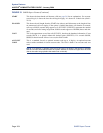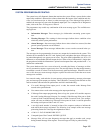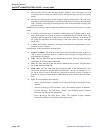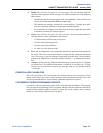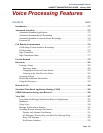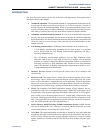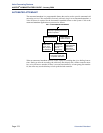
Page 265
System Features
AXXESS
®
ADMINISTRATOR’S GUIDE – January 2004
System Error/Message Printing
SYSTEM ERROR/MESSAGE PRINTING
The system has a self-diagnostic feature that monitors the system. When a system fault or other
noteworthy condition is detected, the software determines the impact of the condition and clas-
sifies it as an alarm (major or minor) or other message type. If the Message Print option is
enabled, the messages are sent to the designated output port. For a complete list of Diagnostics
codes, refer to the Inter-Tel Diagnostics Manual.
The programmer may enable any combination of the error message types. The available mes-
sage types are:
• Information Messages: These messages give information concerning system opera-
tion.
• Warning Messages: The warnings in these messages indicate that a condition exists
which may affect system performance.
• Alarm Messages: Alarm messages indicate that a minor alarm has occurred, but that
general system operation was not affected.
• Severe Messages: These messages indicate that a severe error has occurred in the sys-
tem.
The messages can be programmed to be sent to any output device attached to the system. This
includes devices attached to the CPU card, Options cards, and phone data ports. Messages can
be printed through only one system port at a time. The print width is adjustable (64, 80, or 132
characters) to accommodate different output devices. When a line of information is longer than
the programmed width, the information is printed on subsequent lines and preceded with “+” to
indicate the continuation.
The system database also has a reserved area for recording the history of messages to allow
service personnel to request a report at any time. The message history area has enough memory
to maintain a record of at least 50 of the most recently generated messages. When the reserved
area is full, the more recent messages begin to replace the older ones so that the most recent
messages are available.
In a network setting, each node has its own message print programming, message print output
port, and message print output port backup. There should be a message print terminal at each
node to monitor node and network performance and aid in troubleshooting.
• If a node’s Message Print output port is a node, the network sends Message Print
records to the specified node.
• You cannot select a node as the message print output port backup.
• If Message Print output programming forms a loop, the system will send the output to
the node’s backup Message Print port. For example, if the Message Print port on Node
1 routes to Node 2 and the Message Print port on Node 2 routes to Node 1, the configu-
ration will cause an infinite loop. Message Print reports for Node 1 would be printed to
the backup serial port on Node 2 and vice versa.
• A two digit node number is inserted in front of the sequence number to indicate the
node where the message originated. The following is an example of the new message
print string format for a message the originated on node 3:
• -03:001- 15:30 03-20 M6009 WRN EG CP
• Corrupted Queue Was Cleared: HISTORY QUEUE
• Message Print will not route diagnostic messages that apply to another node, except
during manual Message Print requests. Those messages will only be printed locally.




